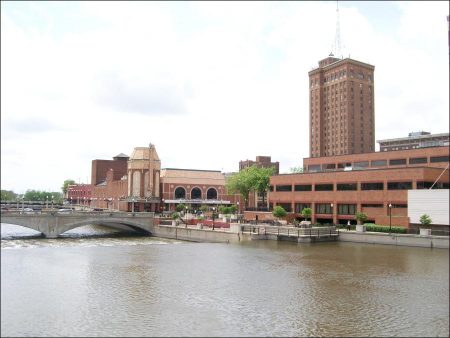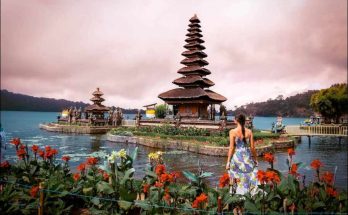Aurora (638 alt., 175,952 pop.) lies on both sides of the Fox River, spreading over the broad and gentle valley through which once rushed a wide glacial stream. Although only an hour from Chicago, Aurora is no suburb, but serves rather as an outpost of the metropolitan industrial area, at the border where factories make their last stand against the checkered prairie.
The river that divides the city into what were once East and West Aurora has many islands; on the major one, Stolp’s, lies the civic center, with the city hall, postoffice, and library. Although water power is now of inconsiderable importance, many of the industrial plants lie along its banks.
When the first settler, Joseph McCarty of Elmira, New York, came to this region in 1834, he found a large Potawatomi village on the river. “It was not a wild, desolate, unpopulated region,” he wrote, “for we had plenty of neighbors in the red men. The village and vicinity contained from 300 to 500 Indians, and we had many visits from them. Quite a commercial trade sprang up, especially swapping bread and tobacco for fish, of which we soon found they had much the larger supply. We could give but one slice of bread for a fish weighing from three to five pounds.”
After beginning work on his cabin, McCarty took a short jaunt eastward to look over the little village of Chicago. Deprecating the place as “more promising for the raising of bullfrogs than humans,” he returned with satisfaction to the site he had chosen on the Fox Rivet. There he was shortly joined by his brother, Samuel, who aided in damming the river and erecting a mill. The McCartys were the first of the small but steadily growing stream of settlers that came to the valley after the Black Hawk War had rid Illinois of Indians. When the sawmill was finished in 1835, there were more than a dozen pioneers to join in the celebration. Platted in 1836, the little community had thirty families and a postoffice within a year.
For a decade and a half Aurora grew along both sides of the river, bound to it because it was the only suitable power source for the first crude industrial plants. Then, in 1848, the forerunner of the Chicago, Burlington and Quincy Railroad extended its lines into town. It is difficult to appreciate, today, the effect the absurd little locomotives and their diminutive cars had upon towns in the fifties. Illinois at that time was entering a period of expansion, but in those towns that lay in the route of the railroad the expansion was intensified. And Aurora not only got her railroad early, but the line also later established its shops here.
Like many a river community, Aurora grew up as two towns, and it was not until 1857 that East Aurora and West Aurora incorporated as a unit. Rivalry at one time was intense, and urchins from one side of the river crossed to the other only with great caution, fearing chauvinistic urchins from the opposite side who looked upon them as foreigners. Fierce verbal battles were fought, even after the towns were united, over the location of the postoffice, railroad station, and other public or semi-public buildings. Streets underwent a change of name in crossing the river; for a long time the mayor was chosen alternately from the east and the west sides. Eventually a convenient solution for the left and right bank rivalry was found in the middle of the river–at Stolp’s Island. The civic center was established there, and citizens wondered why they hadn’t thought of it before.
In 1881 Aurora became the first town in Illinois, and among the first in the nation, to light its streets with electricity. Aurorans were impressed by the yellow glow on top the high steel towers, although a few cynics remarked that “the heavens were better illuminated than the streets.”
Later there arose a persistent fiction that Aurora took its name from this pioneering in illumination, but the town was named long before Edison began to putter with filaments. The early settlers had wanted to name the town Waubonsie, for the friendly Indian chief who once lived here. When it was found that the name had already been given to a town, “Aurora” was chosen as the best philological substitute, since the meaning of Waubonsie was also “morning light.”
In 1893 all Aurora was arguing over its last mayoralty election. No one was sure who was mayor; on the first count John Murphy defeated James Brattle by one vote, and then a recount gave the victory to Brattle by five votes. The election was then thrown into the courts, and was fought to the State Supreme Court, which eventually decided in Brattle’s favor. But his victory was little more than a technical one, because when he finally took office, only four months remained of his two-year term.
By 1890 Aurora had reached 20,000 population, and its subsequent history was that of an even-paced expansion of its industrial basis. The booming years of the new century saw a steady growth, not as spectacular as that of many another industrial town, but subject to little fluctuation. For the 1890-1900 period its percentage of increase in population varied less than 3 per cent from decade to decade, remaining near 20 per cent.
Visits: 125



